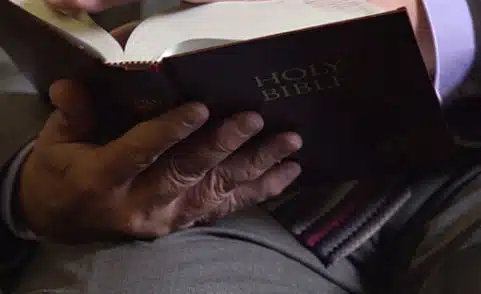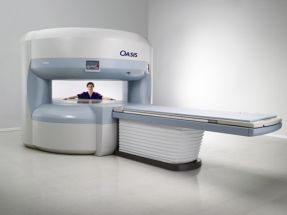
An MRI Helps Return This Pastor To His Pulpit
Posted In: MRI
Finding an imaging center with an alternative to a traditional MRI was key for Stuart George. The shoulder and neck scan his doctor ordered didn’t go as planned. To Stuart’s surprise, his broad shoulders made the sides of the MRI seem uncomfortably close. “Too tight, too claustrophobic. It wasn’t good for me. I couldn’t handle it,” Stuart said of the MRI that never got finished. “For me, it’s more about touching the sides of something I’m going into, like a tunnel or a pipe.”
That’s how Stuart ended up at the RAYUS Radiology’s Kirkland location. He figured if he could get his exam in an MRI without sides, one where he could look out at the room, he might make it through. What he wanted was RAYUS’s High-field Open MRI.
 Technologist Terry Trescott sees a lot of patients like Stuart who need another option. “The traditional, open-ended bore has sides to it so it may put pressure on the arms or the shoulders, depending on the size of the patient.” Terry says the shape of the High-field Open MRI is different. “Nothing pushes on the arms or shoulders, it’s just a lot more open and feels more comfortable.” Terry’s patients are often relieved when they walk in the room and see the machine.
Technologist Terry Trescott sees a lot of patients like Stuart who need another option. “The traditional, open-ended bore has sides to it so it may put pressure on the arms or the shoulders, depending on the size of the patient.” Terry says the shape of the High-field Open MRI is different. “Nothing pushes on the arms or shoulders, it’s just a lot more open and feels more comfortable.” Terry’s patients are often relieved when they walk in the room and see the machine.
The size of the MRI can be an issue for three types of patients:
1. Claustrophobic:
According to a report from Statistic Brain and research by the National Institute of Mental Health about 2.5% of the population suffer from claustrophobia. RAYUS appointment schedulers pre-screen patients over the phone by asking important questions to identify claustrophobic concerns.
2. Obese, Bariatric or High BMI:
Research by Gallup puts the Seattle metro obesity rate at 22.8%. “The Seattle-Tacoma-Bellevue area ranks as the 10th-lowest among the 52 metro areas with populations of at least one million,” according to The Seattle Times’ Gene Balk. Though Puget Sound is fitter than other big cities, the University of Washington’s Center for Obesity Research calls weight, “One of the most complex and costly health concerns facing Americans.” For patients with a high BMI in need of an MRI, the complexity is clear. A traditional MRI exam may not be comfortable or even possible.
3. Broad-shouldered:
In the same way, the 50 cm (20 in) diameter of a traditional MRI can seem tight for a bariatric patient, and men with broad shoulders can find the exam uncomfortable. When Stuart’s shoulders touched the side of the machine, he called it quits. “A lot of it’s just up here,” Stuart says pointing to head.
Some of Terry’s patients are facing more than one of these three issues, leading them to seek out the High-field Open MRI or another alternative MRI option. “I would say 85-90% of my patients are claustrophobic and in combination have a higher BMI.”
To make sure patients end up with the right exam based on body size and claustrophobic issues, RAYUS calls every patient and asks a list of questions before the appointment. Lauren Tannesen makes those calls all day long. “Oftentimes patients don’t realize they’re claustrophobic until they come in,” Lauren explains. “If they say, ‘Oh I do get a little bit nervous in tight spaces,’ or something like that then we would follow up to see what’s going to be the right scanner for them.”.
Even with claustrophobia or size challenges, when booking the appointment the screeners also factor in which body part is being scanned. If a patient is getting an ankle or leg scanned, it may be easier to get through a traditional MRI. In those cases, most of the patient’s body isn’t inside the magnet. Lauren says, “It’s up to the patient, but we really try to give them as much knowledge as possible before so they can make the right decision.”
Patients are encouraged to discuss anxiety concerns with their referring provider before their MRI to determine if a prescription for pre-medication is right for them.
Older model low-field Open MRI exams used to take an hour and the images from them weren’t as clear as those from a traditional scanner. But with the High-field Open MRI, patients don’t sacrifice image quality and most are in and out in 60 minutes. Exams go more quickly when patients are able to relax and hold still as the technologist gets the images. While RAYUS’s schedulers try to keep the High-field Open MRI open for patients who really do need it, there’s high demand and appointments fill up quickly.
Terry says when her patients are finished with their exams they aren’t just relieved. “Most people are thankful that they are able to do the open scan because it was a more pleasant experience and it was faster than they had anticipated.” One look at the High-field Open MRI made all the difference for Stuart George. “When you walk in, you see it, oh cool. It’s not that big round tunnel.” With the help of a sleep mask and a calm technologist talking him through it, Stuart got the images he needed for his doctor to plan his treatment.